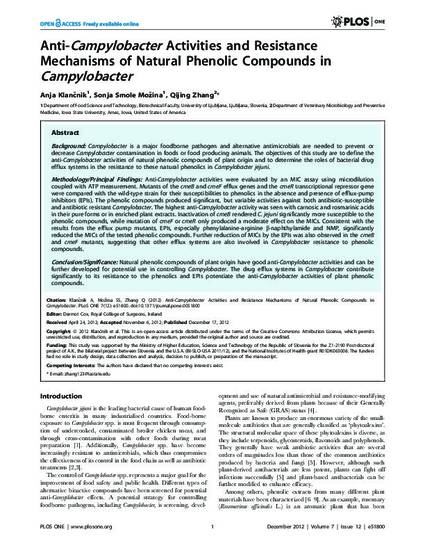
Article
Anti-Campylobacter Activities and Resistance Mechanisms of Natural Phenolic Compounds in Campylobacter
PLoS ONE
Document Type
Article
Disciplines
Publication Version
Published Version
Publication Date
12-17-2012
DOI
10.1371/journal.pone.0051800
Abstract
Background
Campylobacter is a major foodborne pathogen and alternative antimicrobials are needed to prevent or decrease Campylobacter contamination in foods or food producing animals. The objectives of this study are to define the anti-Campylobacter activities of natural phenolic compounds of plant origin and to determine the roles of bacterial drug efflux systems in the resistance to these natural phenolics in Campylobacter jejuni.
Methodology/Principal Findings
Anti-Campylobacter activities were evaluated by an MIC assay using microdilution coupled with ATP measurement. Mutants of the cmeB and cmeF efflux genes and the cmeR transcriptional repressor gene were compared with the wild-type strain for their susceptibilities to phenolics in the absence and presence of efflux-pump inhibitors (EPIs). The phenolic compounds produced significant, but variable activities against both antibiotic-susceptible and antibiotic resistant Campylobacter. The highest anti-Campylobacter activity was seen with carnosic and rosmarinic acids in their pure forms or in enriched plant extracts. Inactivation of cmeB rendered C. jejuni significantly more susceptible to the phenolic compounds, while mutation of cmeF or cmeR only produced a moderate effect on the MICs. Consistent with the results from the efflux pump mutants, EPIs, especially phenylalanine-arginine β-naphthylamide and NMP, significantly reduced the MICs of the tested phenolic compounds. Further reduction of MICs by the EPIs was also observed in the cmeB and cmeF mutants, suggesting that other efflux systems are also involved in Campylobacter resistance to phenolic compounds.
Conclusion/Significance
Natural phenolic compounds of plant origin have good anti-Campylobacter activities and can be further developed for potential use in controlling Campylobacter. The drug efflux systems in Campylobacter contribute significantly to its resistance to the phenolics and EPIs potentiate the anti-Campylobacter activities of plant phenolic compounds.
Rights
This is an open-access article distributed under the terms of the Creative Commons Attribution License, which permits unrestricted use, distribution, and reproduction in any medium, provided the original author and source are credited.
Copyright Owner
Klančnik et al.
Copyright Date
2012
Language
en
File Format
application/pdf
Citation Information
Anja Klančnik, Sonja Smole Možina and Qijing Zhang. "Anti-Campylobacter Activities and Resistance Mechanisms of Natural Phenolic Compounds in Campylobacter" PLoS ONE Vol. 7 Iss. 12 (2012) p. e51800 Available at: http://works.bepress.com/qijing-zhang/7/

This article is from PLoS ONE 7(12): e51800. doi:10.1371/journal.pone.0051800. Posted with permission.